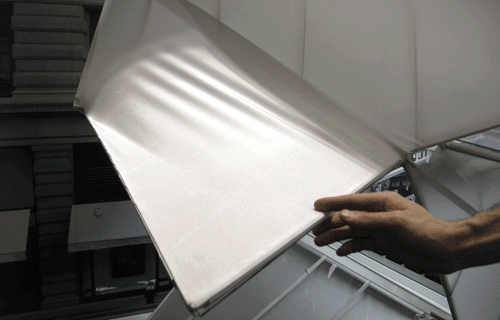MADISON AVENUE (DOLL)HOUSE
New York, New York
CLIENT Calvin Klein, Inc.
PROGRAM (Doll)House for the “Calvin Klein Woman,” displayed in the Calvin Klein Collection storefront on Madison Avenue during the 2008-2009 holiday season
AREA Dollhouse: 4.0 m² (43 sf); Concept House: 190 m² (2,000 sf)
WEIGHT 450 kg (1,000 lbs)
COST Confidential
STATUS Completed 2008
ARCHITECT REX
PERSONNEL Jeffrey Franklin, Joshua Ramus, Jacob Reidel, Alejandro Schieda, Eugenia Zimmermann
CONSULTANTS Magnusson Klemencic, Situ Studio
Calvin Klein’s Senior Vice President for Creative Services approached REX to design a concept house showcasing pieces from the company’s apparel, accessory, and home lines. The catch: the house would be realized in miniature and displayed in the main window of Calvin Klein’s Madison Avenue store during the 2008-2009 holiday season. REX dubbed this fusion of concept house and doll house a “(Doll)House.”
For a practice committed to using constraints as generative opportunities, the project was challengingly whimsical, presenting an exciting (and fun) opportunity to test the limits of our methodology across multiple scales.
A response to two markedly different scales and purposes, the (Doll)House had to reconcile—in one design—the contradictory constraints of a concept house and a doll house:
1. The concept house had to be designed for the “Calvin Klein Woman,” a professed city-dweller; the doll house typology is traditionally a suburban, detached, single-family dwelling.
2. The concept house had to provide privacy for its hypothetical inhabitant; a doll house has to be open, at eye-level, and easily viewed in the round.
3. The concept house had to respect the minimalist aesthetic of Calvin Klein; the doll house had to be bold enough to attract the attention of holiday shoppers.
4. The concept house required a hypothetical site in New York City; the doll house site was already fixed—a Madison Avenue storefront.
By siting the concept house in the ‘landscape’ above a Manhattan intersection, the competing demands of the two scales begins to reconcile. Suspended in air, the concept house remains a freestanding residence while capitalizing on underutilized urban space. Undeniably frivolous, the Madison Avenue (Doll)House nevertheless contains a kernel of an idea for accommodating growth in rapidly-densifying cities.
Meanwhile, elevated and freestanding within the storefront, the doll house can be seen closely in the round and from afar, and can be opened from all sides for play.
Meanwhile, elevated and freestanding within the storefront, the doll house can be seen closely in the round and from afar, and can be opened from all sides for play.
Meanwhile, elevated and freestanding within the storefront, the doll house can be seen closely in the round and from afar, and can be opened from all sides for play.
The conflicting constraints that remained unresolved by the selection of the concept house’s site are reconciled by the (Doll)House’s design itself. The design begins as four, minimalist floor plates (dining room, living room, bedroom, and rooftop pool terrace) following the precedent set for Calvin Klein by John Pawson, the store’s designer.
The plates are then shifted to maximize visibility into the doll house, and to provide views out for the imagined occupant of the concept house.
The plates are then shifted to maximize visibility into the doll house, and to provide views out for the imagined occupant of the concept house.
The plates are then shifted to maximize visibility into the doll house, and to provide views out for the imagined occupant of the concept house.
To balance the opposing desires for views and privacy, the (Doll)House is wrapped in a cocoon of translucent white textile. Conceptually, this fabric layer operates as a sunshade, outboard of a glass façade.
To balance the opposing desires for views and privacy, the (Doll)House is wrapped in a cocoon of translucent white textile. Conceptually, this fabric layer operates as a sunshade, outboard of a glass façade.
The interiors and roof terrace are furnished with miniature replicas of pieces from the company’s apparel, accessory, and home lines. These items were designed by the company’s creative directors: Francisco Costa, Calvin Klein Collection for Women; Italo Zucchelli, Calvin Klein Collection for Men; Ulrich Grimm, Calvin Klein Shoes & Accessories; and, Amy Mellen, Calvin Klein Home.
The interiors and roof terrace are furnished with miniature replicas of pieces from the company’s apparel, accessory, and home lines. These items were designed by the company’s creative directors: Francisco Costa, Calvin Klein Collection for Women; Italo Zucchelli, Calvin Klein Collection for Men; Ulrich Grimm, Calvin Klein Shoes & Accessories; and, Amy Mellen, Calvin Klein Home.
The interiors and roof terrace are furnished with miniature replicas of pieces from the company’s apparel, accessory, and home lines. These items were designed by the company’s creative directors: Francisco Costa, Calvin Klein Collection for Women; Italo Zucchelli, Calvin Klein Collection for Men; Ulrich Grimm, Calvin Klein Shoes & Accessories; and, Amy Mellen, Calvin Klein Home.
The interiors and roof terrace are furnished with miniature replicas of pieces from the company’s apparel, accessory, and home lines. These items were designed by the company’s creative directors: Francisco Costa, Calvin Klein Collection for Women; Italo Zucchelli, Calvin Klein Collection for Men; Ulrich Grimm, Calvin Klein Shoes & Accessories; and, Amy Mellen, Calvin Klein Home.
Image Credits: 1, 2, 3, 7, 8, 9, 13, 16, 17, 18, 19: James Lattanzio; 6: Luxigon; 14, 15: Situ Studio


















